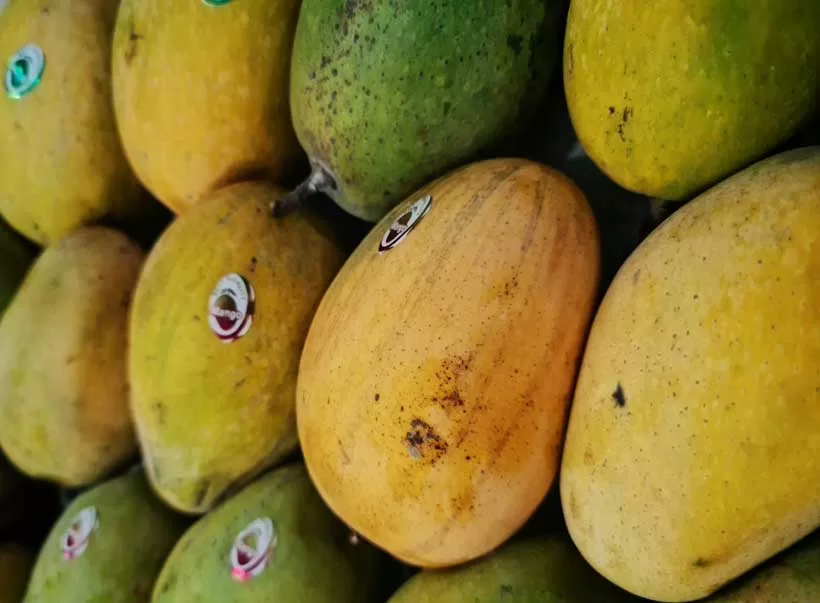This year production of mangoes in Pakistan declines as per mango growers. They argue that 30% to 40% of production in this year is decline because of pest’s attack and climate change. Despite that overall production is still there to meet the domestic demand and then to export. Pakistani Mangoes are mainly exported to Middle East, Dubai, Saudi Arabia, UK, and USA. Mostly 75% of exports are done to GCCs. These exports occur through sea shipment, air shipment, and inland shipment. According to official trade statistics 50 % of mangoes are exported by sea, 35% are exported by land route, and 15% are exported by air.
During mango season, the limited air space availability, reliance on passenger planes, and short notices to exporters who must source mangoes from nearby Karachi and Sindh markets are compelled to compromise quality and hence it effects the prices in international market. Additionally, air transport expenses for European routes take a significant portion of exporters’ margin, exporters are not making a profit on their trade, which deters them from pursuing new business prospects. At Karachi Airport, the absence of suitable lifting equipment for air pallets and insufficient cool storage capacity often leaves loads exposed to extreme ambient temperatures. The inefficiency of Karachi Port, with frequent delays and occasional container shortages, further complicates the logistics. Many small vessels used for transport to the Middle East are slow, inefficient, and barely seaworthy, with open containers offering no temperature control. The inconsistency among exporters is evident in the use of rough wooden crates and inadequate carton designs for sea freight, leading to frequent carton collapse. Moreover, there are no moisture-resistant cartons available. Many exporters lack cooling facilities and rely solely on reefers. The limited knowledge about storage, shipping conditions, and temperatures, coupled with the unavailability of insurance for sea shipments, further decline the export trend. Furthermore, the inconsistent quality and lack of standardization in Pakistani mangoes make it difficult to establish a reliable export supply chain, while inadequate quality control and traceability systems pose challenges in meeting the requirements of high-end export markets. Exporters also struggle with limited post-harvest practice knowledge, poor inventory management, and inadequate market understanding, all of which stifle the growth of Pakistani mango exports.
After production at farm the fruits go to processing where it is washed with warm water to remove dirt’s, and then it is packed to cartons of different sizes. But this processing is not enough some countries like USA demands for irradiation treatment to fruits the facility of which is not present in Pakistan and for that it has to send Dubai for irradiation and then again pack it to export for USA which imply huge costs. During the process Indian exporters in wholesale market of Dubai make their own profit by utilizing Pakistani Mangoes as their own product by labeling and packaging them and earning a lot from our products. This happens because of little branding. In contrast to mangoes from other major producers such as Mexico and India, Pakistani mangoes do not have a strong global brand name. This means that trying to command premium prices in foreign markets is hampered by underinvesting in branding, packaging, and promotional efforts.Further, due to oversupply of Pakistani mangoes in international market prices are down and hence our exporters can not only cover premium prices but the margin of profit is very low. Another factor contributing to low export volumes is inadequate knowledge about and connections to the global market. The majority of traders’ conduct business through one-on-one contacts and do not regularly keep an eye on global prices. Logistic trends are similarly disregarded. Modern markets, on the other hand, organize all these processes with clinical precision and dependable information. They are more profitable and so have a monopoly on the export market.
For Pakistani mango exporters, navigating the customs clearance process and fulfilling different regulatory criteria in the destination nations can be difficult and time-consuming. This involves several steps which includes registration of orchard packing facility in Pakistan, certification and licenses for exporters, obtaining of an FDA registration from government of Pakistan, getting of import permit from APHIS-PPQ in which 526 permits required where PPQ receives over 6000 applications per year. The application processing time is eighty days and it depends upon complexity of request. With this fruit must be neatly packed in APHIS-approved pest-proof boxes, and a certificate must be issued from NPPO Pakistan.
By taking significant steps to improve marketing, packaging, effective supply chain procedures, and product quality, this situation can be made better. Reliable processing facilities have to be established to increase volume of output from mango produce. Processing units bring innovation as well as help in reducing post-harvest losses. Ahead of this, export diversification to other markets like of European countries, African countries, Iran, and China may be the potential source of the profitability. Hence, exports diversification is required for Pakistan. Simplification of regulatory compliance can enhance export trend e.g, On-line application submission using eFile can save up to thirty (30) days.) in case of imports permits from USDA (US department of agriculture)/APHIS. Proper branding and availability of international standard packaging can enhance exports and for that processing facilities and infrastructure must be provided to exporters so that our products can get benefit.
